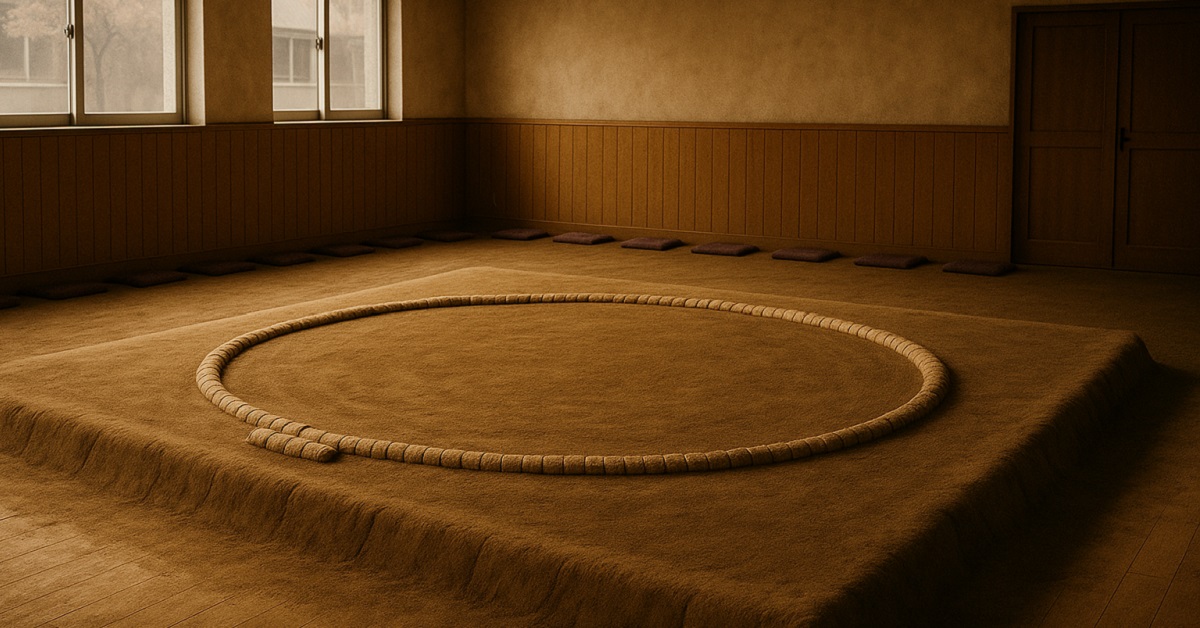The dohyō is the sacred arena where sumo, Japan’s national sport, unfolds. It is not just a competition space but a powerful symbol of tradition, spirituality, and national identity. This article explores the structure and cultural essence of the dohyō in depth.
Structure of the Dohyō (sumo ring)
The dohyō is a circular ring with a diameter of approximately 4.55 meters. It holds a wealth of tradition and history, serving as the official ground where sumo bouts take place. The boundary of the ring is marked by a raised rim of tightly packed clay and straw bales (tawara), forming a visible line for determining victory or defeat.
The dohyō is built in a raised platform style called “takadoko”, which enhances visibility for spectators and highlights its sacredness. Two white lines, known as shikiri-sen, are drawn at the center, indicating where wrestlers position themselves before the match begins.
The dohyō is made from hard-packed clay with a surface layer of fine sand, which serves to prevent slipping and allows clear judgment based on footprints.
| Element | Details |
|---|---|
| Shape | Circular |
| Diameter | Approx. 4.55 meters |
| Boundary | Made with clay and straw bales |
| Material | Clay and sand |
| Structure | Raised platform (takadoko) |
| Center Lines | Shikiri-sen (white lines) |
| Purpose | Fair play, visibility, sanctity |
Materials and Craftsmanship Behind the Dohyō (sumo ring)
A dohyō is not just a patch of earth. It is carefully handcrafted by specialists known as dohyō-chikushi. Layers of selected high-quality clay are compacted to form a sturdy surface. The structure also accounts for drainage and air circulation to maintain stability.
The placement of straw bales is especially crucial. Arranged with exact spacing in a perfect circle, they provide a physical boundary that influences match decisions. Finally, fine sand is sprinkled on the surface, playing a dual role in preventing slips and making footprints visible for refereeing.
Before being used, the dohyō undergoes a purification ritual known as dohyō matsuri. This ceremony involves placing items such as salt, sake, kelp, and dried squid at the center of the ring, expressing gratitude to the gods and wishing for the safety of the wrestlers.
| Process | Description |
|---|---|
| Clay layering | Packed in even layers |
| Bale placement | Precisely aligned by hand |
| Sand application | For grip and footprint visibility |
| Ritual | Dohyō matsuri using salt and sake |
Spiritual Significance and Historical Background
The origin of the dohyō can be traced back to ancient times when sumo was performed as a ritual to honor the gods. In agricultural societies, sumo was held as part of ceremonies to pray for good harvests, and the dohyō was viewed as a space connecting gods and people.
Today, these traditions continue in professional sumo tournaments. Prior to each tournament, a religious ceremony purifies the ring. Items like salt, rice, sake, kelp, and dried squid are buried at the center, and shimenawa (sacred ropes) are placed around the four corners to indicate that the ring is a sacred area.
Actions like sprinkling salt and stamping the feet (shiko) before matches are more than routines; they are spiritual gestures that purify the space and ward off evil. Through these practices, sumo retains its role as a cultural and spiritual tradition, not just a competitive sport.
| Ritual Element | Meaning |
|---|---|
| Dohyō matsuri | Prayer and gratitude to the gods |
| Salt throwing | Purification and protection |
| Shiko (stomping) | Driving away evil spirits |
| Shimenawa | Marking the ring as a sacred space |
The Dohyō (sumo ring) in Education and Local Communities
Today, the dohyō is also used in education and community events. In schools, sumo is introduced in physical education classes, where children learn about discipline, respect, and focus through simplified dohyōs. The ring becomes a tool to instill cooperation and resilience.
Local shrines and festivals often feature offering sumo (hōnō-zumō) events on traditional dirt rings, deepening ties among residents and preserving regional traditions. Children’s sumo tournaments serve to pass cultural heritage to the next generation while strengthening community unity.
| Application Area | Purpose and Significance |
|---|---|
| School education | Teaching manners, strength, focus |
| Shrine rituals | Cultural preservation, spiritual unity |
| Children’s sumo | Inheritance of tradition, community bonding |
| Local festivals | Regional identity, tourism promotion |
Modern Use of “Dohyō (sumo ring) ” as a Metaphor
The word “dohyō” is widely used in modern Japanese as a metaphor for competitive situations. Phrases like “on the same dohyō,” “on the edge of the dohyō,” and “stepping into the dohyō” are commonly used in business, politics, and everyday speech.
These expressions derive from the concept of the dohyō as a decisive battleground, extending to describe fair conditions, critical moments, and courageous challenges in various fields.
| Expression | Modern Meaning |
|---|---|
| On the same dohyō | Competing under equal conditions |
| On the edge of dohyō | A decisive, risky situation |
| Stepping into the dohyō | Taking on responsibility or challenge |
Conclusion
The dohyō is more than a competition ring — it is a symbol of Japan’s cultural essence. With its meticulously crafted structure, ritual significance, educational value, and metaphorical presence in modern language, the dohyō embodies the nation’s spirit of respect, discipline, and sacredness.
Learning about the dohyō offers a deeper understanding of Japanese tradition, its spiritual roots, and its ability to bridge past and present. Whether as a physical space or a symbolic expression, the dohyō continues to shape how Japanese people view challenge, ritual, and honor.





コメント